Important pre-viewing: https://www.youtube.com/watch?v=SRH-Ywpz1_I
While the game we play may be called Netrunner and not ICERunner or NetICEr, ICE is perhaps the most memorable and defining card type in the game. It is also one of the trickiest card types to evaluate. I’m going to break down how to evaluate ICE and ideally try to draw some larger lessons about Netrunner (like how the real way to evaluate ICE is by its meme potential [looking at you, Cobra … sssssss]).

Oddly enough, I’d like to start this article about ICE is by talking about an Operation. That Operation is called O2 Shortage and is a very good example of a punisher card. ‘Punisher card’ is a term that comes from Magic The Gathering and has the general format demonstrated in O2 Shortage – you play it and your opponent gets to pick one of two things that happen. These cards (justifiably) have a reputation for looking, at first glance, very strong, but in practice, not very good. I’m going to do a quick breakdown of how to evaluate O2 Shortage to get an idea of how to understand the punisher card as a mechanic and discuss why briefly why they’re considered weak in general (and also when they can be strong).
O2 Shortage presents the Runner with two options, equivalent to
- A free Biotic Labor for the Corp
- A Neural EMP that doesn’t trigger I’ve Had Worse, and does not require a run
While both of these are effects on cards that people play, O2 Shortage is not a card that sees any serious play. The reason for this is that giving your opponent a choice makes the card worse, as they will choose the option that is better for them (and worse for you). So in order to make O2 Shortage good, you need to play it in a situation where BOTH of these effects are useful – and even then, your opponent will pick the one that is less good for you. It is only ever as good as the WORST option on the card and to be good both effects need to be powerful AND relevant in the same board state.
All this being said, punisher cards are not inherently badly designed (being of low power level does not make a card of bad design), and in fact can be very interesting. In my opinion, the core of what makes a game a game are the choices you make during it, and the core of what makes a multiplayer game a multiplayer game are how your choices affect your opponent’s choices. Punisher cards, then, are good for multiplayer games as they directly give your opponent a choice based on your own decisions, which forces you to interact with your opponent. They are also not necessarily even bad cards, as you can see by the amount of play Mining Accident sees.
ICE
Now, what does all of this have to do with ICE? Well ICE is a card type that is has the punisher mechanic built in. Let’s take an example of an unknown ICE. The Corp installs it on R&D. Here are the options which the runner has available, none of which involve actually installing a card:
- Never run R&D and win off other servers
- Run R&D forcing a rez,never run again, win off other servers, and take advantage of the spent resources
- Run R&D repeatedly and let the subroutines on the ICE fire
Already, without installing a Breaker or other card, the Runner has 3 options for how to handle the ICE! That is more options than the O2 Shortage had!
What if we additionally consider the options which a runner might have available to actually interact with the ICE:
- Install the corresponding Breaker, run through it repeatedly for single accesses
- Install the corresponding Breaker, and make a small number of high value runs (Maker’s Eye, Indexing)
- Install or use a powerful single use card to remove it from the board, or negate its effect (Parasite, Femme, Emergency Shutdown)
- Install cards to prevent it from being rezzed (Blackmail, DDOS + False Echo)
- Use a bypass effect to avoid interacting with the ICE (Inside Job, Spear Phishing, Feint)
Now, some of these categories are a little ill-defined – (should Femme, Parasite and Emergency Shutdown all be in the same category?), and in a way, every single different card that can break/bypass/destroy a piece of ICE is in its own category. However, the main point here is that there are a lot of ways to deal with ICE! As your opponent is generally intelligent, when you give them all of these options they are sure to pick the best one, which means an ICE is only as strong as the best way which the Runner has available to deal with it. With so many options, one might wonder why anyone ever plays ICE at all! One must remember however that while often punisher cards are bad, not all of them are and punisher cards simply need to be evaluated on their own terms (they are only as good as the best option for dealing with them.
However, overall this tends to come around to doing one of the following 2 things:
- Find a solution for the ICE
- Ignore the ICE
How hard or easy it is to find a solution depends on the deck construction which the Runner has chosen, as well as the nature of the ICE. What happens if the Runner ignores the ICE is even more interesting, as it is under the Corporation’s control! They get to decide what cards to install and protect with ICE, and they are in control of how bad it is for the Runner to ignore a piece of ICE (Vanilla in this scenario). This might mean scoring an Agenda, building a giant Estelle Moon, or gaining credits from Adonis Campaign. How bad it is to just ignore a Remote depends on the Corporation’s deck and board state, and to make a good decision, the Runner needs to make a decision which takes all this into account. The Runner must evaluate the cost of finding a solution (clicking to draw for cards, spending money, using Self-Modifying Code or Special Order) vs. the cost of letting the Remote server go uncontested (points scored, money gained, cards drawn, etc). Evaluating what the best option to take for dealing with an ICE is a complicated decision that is highly dependent on the board state of both sides (cards installed, deck composition, money totals, score). Now, to get a better idea of how to evaluate some ICE I’ll break some different ICE down that I think bring important lessons, but always keeping in the mind the idea that the strength of the ICE is tied to the best option the Runner has for dealing with it.
Breaking Down Some ICE
Vanilla
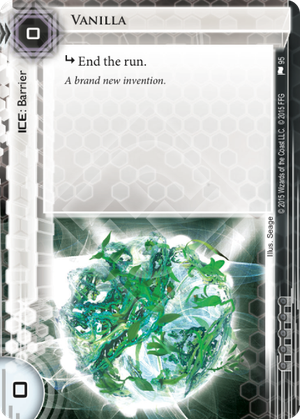
One of the most played barriers in the game, Vanilla is very useful for demonstrating an important principle in ICE strength: choice reduction! At 0 cost with an ETR subroutine, all of the options 1, 2, and 3 listed above are the same thing! If you run into it and let the subroutine fire, it’s the same thing as not running into it (just minus a click for the runner) since you haven’t cost the Corp anything! The Runner’s only options are to install cards to deal with it (or ignore it). While there are many good solutions to Vanilla, (broken by 1 for basically every relevant barrier breaker), each of these solutions need to be found which can be very costly: you need to spend X clicks drawing to find the card, or a tutor, and then a click to install the card, and paying the install cost. Breaking a Vanilla once has a fairly high cost, relative to the very low cost to the Corp. The first time the Runner breaks Vanilla, they are probably spent 5+ clicks on draws, a click for the install, and 4+ credits for the relevant breaker. All end the run ICE have this same property, that the first time it is broken carries a very high cost as there is no way to get around it without finding a card that is a solution.
However, breaking the Vanilla a SECOND time or, breaking a SECOND Vanilla has a very low cost (usually 1 credit). The longer the game goes on, the less valuable Vanilla is relative to a more taxing barrier, as actual break cost of the ICE becomes more relevant, particularly for the creation of scoring windows. This means Vanilla is best in tempo decks where you want to defend something early that will give you a lot of value, at very little cost to yourself. You can, for example, install and rez Estelle Moon, install Vanilla, install Jeeves, and on your next turn rez the Jeeves whereas with a Wall of Static this would not be possible.
Despite its strength, Vanilla does have some weaknesses. Specifically, it is bad against Aumakua relative to other ETR barriers because Vanilla can be broken by Aumakua in the absence of a virus counter. What’s more, while the first Vanilla is extremely good, a second Vanilla is not at all good (usually not worth installing if they can break it). Vanilla is best in decks where you do not have a lot of a barriers (as each copy gets worse) and in decks where you want to protect early powerful resources that cost money (Estelle Moon). It is weak in decks with a lot of barriers, or decks for which the plan against Turtle is to ICE every server and then purge.
Pop-Up Window
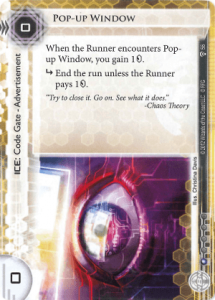
Pop-up Window is comparable to Vanilla in that it also costs 0 to rez, but its effect operates very differently. Unlike Vanilla which requires cards to break it, Pop-up Window can be run through without installing any cards. What’s more, there are no cards that break Pop-up Window better than using no cards (Parasite and Yog were the big exceptions). What Pop-up Window gives you is a reasonably taxing ICE (a 2 credit swing) for 0 credits. Just as with Vanilla, there is no ability to force a rez of Pop-up Window and take advantage elsewhere. As a Runner your options against Pop-up Window are:
- Ignore the Pop-up Window server
- Run through it a lot
- Run through it a couple of times within high impact runs.
Notably, as Pop-up Window is 0 credits to rez and a 2 credit swing, if the Runner chooses options 1 or 2 the corp is getting a great value. If the Runner runs through Pop-up Window 6 times over the course of the game, Pop-up Window has been a 0 cost card that gains 6 credits and costs the Runner 6 credits, which is very strong. However, option #3 is where Pop-up Window tends to have weaknesses. If the Runner only runs through Pop-up Window twICE on a single indexing run, your 0 cost ICE has only gained you 2 credits and cost the runner 2, which is not a very good value. Because of the weakness of Pop-up Window in this scenario, whether or not Pop-up Window is a good ICE is highly dependent on what Runner strategies you expect to see (it is strong vs. run based econ like Desperado and weak vs. sit-back econ and value runs).
Unlike Vanilla, whose ETR subroutine meant it was strong independent of runner strategy (and whose value was largely dependent on your own strategy), Pop-up WIndow’’s value is largely dependent on the Runner’s strategy. This makes it less universally strong, but it still certainly does have a place, as there is really only one good solution to it that requires a certain kind of deck construction. You can see that in despite being a card that saw play pre-rotation (Worlds 2016 Winner) it is no longer a card that sees much play due to the dominance of infrequent, high value run strategies.
Eli 1.0
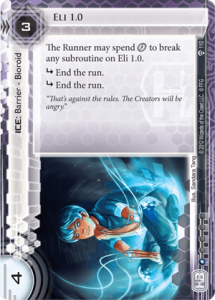
Eli 1.0, while it has rotated and is no longer with us (RIP), is a very important ICE to talk about. When it was released, it was immediately the best ICE in the game, and for a large period of time was far and away the best ICE (up until at least Lady, and probably Knifed came out). Notably like all Bioroid ICE it actually gives the runner MORE options to deal with it (by clicking through). So why was it so good? Well, Eli 1.0 had a low rez cost (3), which meant it was hard to abuse the tempo loss associated with rezzing it by running somewhere else. On top of that, at the beginning of the Netrunner, Corroder was the main Barrier breaker and cost 4 credits to break it! Even just breaking Eli twice was a tax of 8 credits, which is a great trade for only 3 credits to rez. The additional option (paying 2 clicks) is typically considered about as expensive as 4 credits! Even some of the other options such as Atman at 4 strength (a 7 credit install!) only allowed you to break it for 2 credits. Parasite took 4 turns to kill it or cost Datasucker counters (as well as the cost of a card and 2 credit trade for a card and 3 credits). Fundamentally, Eli 1.0 was very good because NONE of the options for dealing with it were good options. There was no way to efficiently break it either once or repeatedly, and it was cheap enough that there was little downside of rezzing it.
Later, as new options were introduced (Lady breaking for a 1 counter and 1 credit, Knifed allowing you to click through it once without installing a Breaker, Paperclip breaking for 3 [with a discount from Datasucker / Ice Carver]). It also got supplanted a little by the fact that other good Barriers were finally printed (Vanilla, Resistor, IP Block). Additionally, its drawback of being able to get broken without a breaker became more relevant,as protecting Estelle Moon became so important in the meta immediately pre-rotation. Eli 1.0 is a strong lesson for the evaluation of ICE by thinking about all the ways to deal with it – and when you come up with no good ways, you end up with a very strong piece of ICE.
Chiyashi
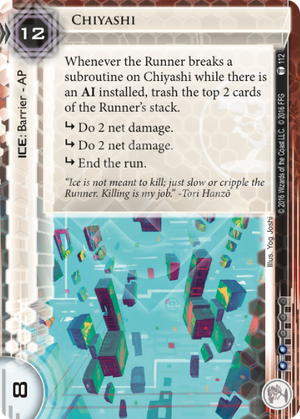
Chiyashi is the third and final barrier which I’m going to talk about in depth. As I alluded to in the section on Eli 1.0, historically barriers have been the weakest ICE type as their subtype-pie restriction means they do not have a facecheck penalty. This means that by default for a big expensive barrier like such Hadrian’s Wall or Curtain Wall, the Runner is able to deal with them in one of the core ways described earlier (run it, take advantage of the resource cost to run elsewhere). Essentially, the cost of facechecking these ICE is a click. These big fat barriers have basically always been bad primarily because of this huge weakness (Blue Sun was somewhat able to skirt this by being able to get back the credits expended on rezzing the ICE and having a combo with Oversight AI).
Chiyashi brings a 4 net damage facecheck penalty which helps balance out its hefty rez cost. Still, most runners will happily take a click and 4 net damage to force the Corp to spend 12 credits. What’s more, as it only taxes Paperclip 7 credits or Lady 4 credits and 2 counters, there are a reasonable ways to break it a couple of times when you need to, as well as the fact that D4v1d + Knifed exists as a very good solution to Chiyashi. Chiyashi has one saving grace, which is that you can play it out of AgInfusion and force the Runner to run into your 12 credit investment multiple times (effectively turning off the “ignore and run elsewhere option).
A quick digression on the design of barriers. A lot of times I see people talk about how Paperclip limits the number of playable barriers. I don’t really think that is true. Rather, I think that barriers are just mostly not actually very good. This is primarily because subtype-pie restrictions mean barriers with the facecheck penalty required to balance a rez cost >4 credits don’t exist (Tithonium and Chiyashi do see play in some deck archetypes). You could heavily restrict barrier breaking options or drastically inflate the numbers so that a 10 cost barrier is unbreakable, but I don’t think that is very good gameplay (see: Ashigaru CI). I don’t think this lack of high strength barriers is a problem so much, as I think there is still huge room for a variety of midrange barriers (IP Block, Kakugo, Seidr Adaptive Barrier, Resistor), but if you want to print large barriers that are usable outside of AgInfusion you need some facecheck penalties. Just, please, no more Fire Walls or Hailstorms!
Fairchild 3.0 / Tollbooth
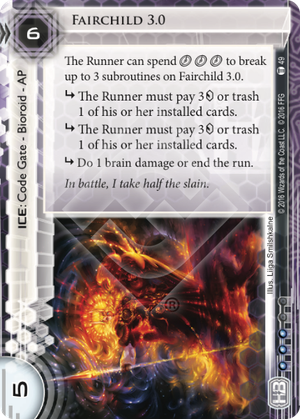
Fairchild 3.0 is the only ICE which is currently restricted and is also the restricted card in the World’s winning Corp deck. Despite being a Bioroid (like Eli 1.0) and costing 6 credits to rez, the Runner has relatively few good ways to deal with Fairchild 3.0. Facechecking it either costs 3 clicks (at ~2 credits a click = 6) or firing subs that cost 6 credits. Crucially, it has an ETR subroutine so you have no ability to let the subs fire and run through. Breaking it costs 6 credits with Gordian Blade, and even Cyber Cypher only breaks for 4. While Yog used to exist, even it struggled to break Fairchild 3.0 effectively, requiring other support cards (Ice Carver, Net Ready Eyes, Datasucker) and costing 5 credits to install on the top of the support cards. There is simply no way to get through Fairchild 3.0 for a small resource investment, and it provides a facecheck penalty that costs the runner close to what it takes to rez it. Compared to the current suite of big, taxing barriers, this is what an effective large taxing ICE looks like.
Tollbooth is another large code gate, and is probably the biggest piece of ICE that has been consistently included in tournament winning decks throughout Netrunner. Notably, with a rez cost of 8 credits, and a tax of 3 credits on encounter, it is way more vulnerable to ‘tax and run elsewhere’ strategies. However, due to the nature of the encounter ability, there is almost no way to get around paying a decent chunk of money every time you run through it. Gordian Blade breaks for 7 credits,and Cyber Cypher for 5 credits. Even the methods of destroying Tollbooth (Parasite + Datasucker, D4vid + Spooned) usually require a large investment of resources by the Runner, who has to encounter Tollbooth twice (once to force the rez, and the second time to destroy it with either Spooned or Parasite). Even Femme, which allows you to bypass the Tollbooth for 1 credit is a 9 cost Runner card that represents a large investment. The biggest weakness of Tollbooth is that 8 credits is a huge resource investment and the runner only has to pay 3 credits when it is rezzed. However, Tollbooth has consistently been the go-to ICE for decks that want the ability to create a server into which it is extremely taxing to get in. A lot of this has to due with the Encounter ability having much more limited options for dealing with it (Hunting Grounds, Femme, Security Nexus) meaning the best ways to deal with it generally still involve paying at least 3 credits a couple times.
Cortex Lock
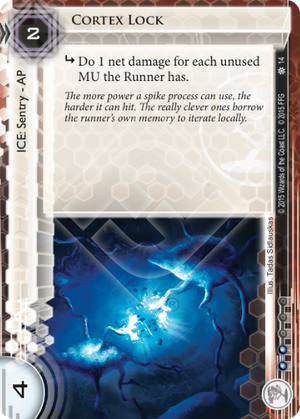
Cortex Lock is the final piece of ICE I’d like to talk about, and is one of the few Jinteki ICE I think is truly good (DNA Tracker, Kakugo, Komainu being the other 3). At a rez cost of 2 credits and with no Runner cards installed, it deals 4 net damage when run through! This is both very hard to run through repeatedly and is a great trade for the Corp player that limits the ability of the Runner to attack elsewhere (as they need the cards to prevent dying to Snares or Hostile Infractures). What’s more, due to being a 4 strength sentry there are not really any good ways to break this ICE (Na’Not’K for 4 credits, Mimic needs a Datasucker counter, MK Ultra breaks for 6). However, there are two big downsides:
- The Runner can install programs until their memory is full at which point they can run through Cortex Lock with no consequences
- Without other damage sources, even 4 net damage is not the worst thing in the world for the Runner to take.
What this means is that Cortex Lock is best in decks where there are not many useful programs to install against it. This largely means low ICE count decks as the runner does not want to install expensive breakers and ICE solutions just to blank cortex lock. You also need to be decks were running on low Card totals is dangerous, as this means after hitting a cortex lock the runner is then forced to spend the rest of their turn drawing up to avoid dying. This typically means putting it in an IG deck with a low ICE count that has high value early targets to protect (Estelle Moon, Jackson Howard, Archives). On top of that, Cortex Lock brings something to the table that a lot of the ICE we’ve talked about don’t have. Not only does it trade evenly with the runner on facecheck the way other ICE do (Vanilla, Fairchild 3.0), the runner is hurt way more than the rez cost to the Corp. This means it has a broader effect in that if the runner knows you have them it makes them less likely to run other ICE as well. All facedown ICE can potentially be Cortex Lock, which means the solution to other ICE is taken away. For example, if the Runner has a Paperclip in the bin they still might not run a facedown Vanilla because even though they have a good solution to the Vanilla, they do not have a good solution to the Cortex Lock it could be.
A Holistic Understanding of ICE Strength and Composition
As I started out with, ICE are cards that have a punisher mechanic baked in, and so to evaluate them, you need to understand what is going to be the best option for the Runner to deal with them. However, what this will be will also depend on both the rest of your deck composition (economy, what you’re protecting with the ICE, etc) as well as what options the Runner has in their deck to deal with them (ICE Breakers, other tools). There are relatively few ICE (Eli 1.0, Fairchild 3.0) that are so universally strong against every way of dealing with them that they fit in every deck in every meta. This is a good thing, and I think to a certain extent they were both mistakes (though Eli 1.0 eventually had sufficient counters designed into the game that it was no longer universally the strongest ICE) and the game is more interesting when you need to consider both your own strategy, and your opponent’s strategy in deciding what ICE you will use.
To give a concrete example of how a deck might select its ICE, I’ll break down the ICE selection for the World’s Comrade CtM deck. Resistor is the first ICE to talk about, as it contains a huge drawback, relative to Vanilla, in that the Runner can always pay 4 to get through the trace. This is an extra option that is often relevant (the Runner can pay 4 to stop an Agenda score without needing a breaker, or trash a high value asset). However, this weakness is mitigated by the fact CtM does not typically want to rush out Agendas, and its assets are usually sufficiently protected by the native ID ability of CTM. On top of that, when the Runner takes tags suddenly the option to break Resistor for less than 4 credits get taken away. So Resistor’s weaknesses are largely mitigated by the plan of CtM, and its strength is very important, as I’ll get to when I talk about the next ICE.
Data Raven is in many ways the opposite of Resistor. It is extremely taxing to get through when you do not have tags (a click and 2 credits + trace / breaking it!), but if you start floating tags one can run through it for free. In isolation, this is a major weakness, since if running through a Data Raven is a good option for the Runner, then it is a very weak ICE. The deck has to slot tag punishment cards (Quantum Predictive Model, Psychographics, Exchange of Information, IP Block) in order to make ‘just float tags’ a bad option. In these circumstances, Data Raven is a very strong and taxing piece of ICE, but it requires all of these other cards to support it.
IP Block is another card that, like Resistor, has strong numbers, but with downsides (the Runner can pay always 3 credits to get through, unless the Corp has sufficient credits to boost the trace). Like Resistor, it makes Data Raven stronger, by making the consequence of floating tags worse as the runner can no longer just pay 3 credits without an ICE breaker. On top of that, it is an important component vs. certain runner strategies we expected to see. It is the best ICE in the deck against Aumakua, and the fact it taxes a tag or 3 credits on facecheck means that it discourages repeated runs on centrals with the Turning Wheel installed.
There are two code gates, Enigma and Tollbooth. For a while we were running 2x Enigma because it was important to force a Decoder install (as I discussed in the Vanilla section, the first ETR ICE of a type installed is extremely strong), but what we found is that the second Enigma was always bad to draw. Tollbooth on the other hand was often too expensive to rez in games where the runner was trashing our ccon, but it was the most important ICE for games where the Runner just let our econ go, as we could easily rez it and force the Runner to run through it again and again, taxing out even the most extreme Runner econ. Even though it was useless in low econ games, in those games the rest of our deck was strong enough that we could deal with having 2 blank ICE. The Tollbooth helped us against the strategies that let us have lots of money (which we were weaker against), and this is an important principle that you want to alter your ICE to patch up the Runner’s strongest strategy against you.
Finally, Architect. Architect provided us with a bunch of things. First off, it is extremely bad to not break Architect against a deck with as many strong Assets as CtM, so it forced a sentry breaker for the Runner. This was important since Data Raven subroutine is generally circumvented for 3 credits by paying the trace. Secondly, it was taxing against the sentry breakers we expected to see the most of (MKUltra, Femme on Data Raven, Na’Not’k). Finally, as with IP Block, it provided an important tool to turn off The Turning Wheel.
Overall, all the ICE slots in this deck required us to think about how the best way to deal with them could be alleviated by other ICE or cards. Resistor helped make running through Data Raven worse, and Architect was a good complement to Data Raven. The deck needs to have a plan if the Runner aggressively trashes econ, but also have a plan if they don’t (Tollbooth). Testing to figure out what the weakest points were and then altering ICE selection and other deck slots to fix them was a tricky process. Overall this deck only has 3 hard EtR ICE (good job Damon!), which leads to the Runner having more interesting decisions on how to deal with them (sometime it is right to go tag-me, sometimes it is right to risk an Architect fire, sometimes it is right to just pay through the Resistor trace). A fun task might be to examine the different ICE in Chris Dyer’s World’s CtM from 2016 and think about how the deck and meta composition led to different ICE selection choices.
Diversity of Runner Solutions (Or SimonMoon Yet Again Harping On Why Parasite Was Good)
For as long as I have played Netrunner, people have complained that ICE X is bad because Parasite kills it (‘dies to Doomblade’). While it was true that Parasite was the best solution to some ICE, that does not make Parasite bad design (or even the ice it was good against bad!), as there is always going to be a “best” solution for any given ICE. If you get rid of all solutions to ICE that are not ICE breakers, you reduce the pool of playable ICE in the game. Parasite might be the best solution against Komainu, while Lady is the best against Eli, and Emergency Shutdown against Chiyashi. When you have all these different Runner solutions which the Corp needs to consider, the Corp will select a more diverse pool of ICE as they need to have good ICE against all the different solutions they expect to run into. When all you have are standard boost and break ICE Breakers, ICE gets flattened into a smaller number of characteristics (break cost, hard ETR, facecheck, rez cost). This means that the same ICE are more universally good. Cards like Turtle mean you actually have a reason to run Wall of Static over Vanilla if your plan involves shutting off centrals, while against purely standard Breakers Vanilla is just miles better. Diversity of solutions leads to diversity of ICE selection and diversity of gameplay.
Assets
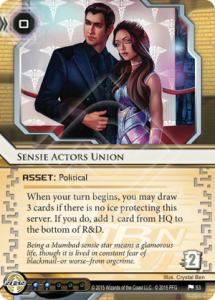
I’ve spent this whole article talking about ICE, and why ICE is a strong and interesting mechanic (which I think is a generally popular sentiment) but I think it is important to talk about the other types of cards. Assets tend to have a negative connotation, but I think Assets are crucial to Netrunner being a fun game. Take even the simple PAD Campaign: the runner has 4 choices:
- Try to find it before rezzed and trash it
- Trash it immediately after being rezzed
- Trash it in the future
- Never trash it
For a card like PAD Campaign, this choice is hard because the options are generally fairly close in value and depend on the exact board state, and this is a good thing because it means whether or not to trash the PAD Campaign is an interesting decision. From the Runner’s perspective, a card like PAD Campaign is way more interesting than Hedge Fund, which leaves little room for decision making. Econ like Sundew and Adonis Campaign that lead to higher payouts, but also can be protected by ICE are also especially interesting, as this in turn leads us back to all the interesting decisions that ICE gameplay has.
Assets tend to reduce runner options when the effect is so powerful that trashing immediately (or preemptively) are the only good option in any scenario, but for the most part current assets are not really that strong (with the exception of the restricted Estelle Moon). The Political Assets (Bio-Ethics Association, Clone Suffrage Movement, Sensie Actors Union, Commercial Bankers Group) are another group of high powered assets that tended to lean towards option (1) being the only good option (SAU and CSM especially so). At this point, lots of people are probably putting together the fact that they are high powered and cannot be protected by ICE and that this in turn subverts the interesting ICE based decision we have in the game. This is true-ish, but I still think a lot of these lead to good high quality gameplay.
As they only cost 2 to trash across the board, relative to PAD Campaign trashing one is low cost to the runner so without ICE the Corp needs to defend them in other ways. The Corp can hide them in a mind field of traps (Psychic Field, Shock). The Corp can protect them with different assets that are in turn protected by ICE (Hostile Infrastructure, Encryption Protocol). The Corp can protect them with ID abilities (CtM, IG) that in turn need unique deckbuilding and play restrictions to work (tag punishment slots, Icing Archives). All of these involve decisions that are nontrivial and board state dependent.
Against CtM you might need to evaluate how bad a Sensie Actor’s Union fire is vs. the risk of floating a tag and getting Closed Accounts vs. the risk of it being a Virtual Tour vs. how good your own options are (Temujin Contract, Liberated Account & Daily Casts). This was a real decision, a hard decision, and a decision that was highly dependent on a lot of factors (what cards are in hand, credit counts, what cards you’ve seen, score, etc). The more fun versions of IG (49, Moons) had even more interesting decisions about when to check unknown remotes, when to run Archives, when to try and score points, which utility asset (Hostile Infrastructure, Genetics Pavilion, Turtlebacks, Daily Business Show) to trash and when. I would want not Netrunner to only be this style of deck, but I think there is certainly room for Netrunner to have decks of this style and they add good gameplay and printing assets that could not be iced let their power level be good enough to encourage the runner to find them before they get rezzed.
Conclusion
This has been an article batting around my head for a long time, and I’m glad I’ve finally been able to write it all down. Like most ideas, it was not the result of my thinking alone but was the result of a lots of lengthy discussions (arguments) over a long period in Stimhack Slack. In particular, I’d like to thank hella Ben Blum who got me onto thinking about ICE as a punisher mechanic, Nemamiah who crystalized a lot of my thoughts about Big ICE and Diversity of Solutions, and Josh01 who I stole something from in here, but I can’t quite remember what. Additional thanks to Tolaasin, Josh01, and Higgs Bozo who helped my pile of words turn into a readable, grammatically respectable article.
Hopefully, there are some lessons that can be gleaned from this. From a personal play perspective, understanding how to evaluate ICE based on the best solution for the Runner will help you include top notch ICE (as well as design your deck around mitigating and removing the weaknesses of your ICE). From a design perspective, hopefully we can stop printing stupid giant useless barriers, and reprint an exact copy of Parasite. Or maybe the lesson is to simply marvel about how Netrunner is such a wonderful game, with so much choice baked into its mechanics. At its core, it is a game where your decisions matter tremendously for your opponent and continuously present them with tough decisions of their own. But srsly, no more stupid Weyland Walls.




